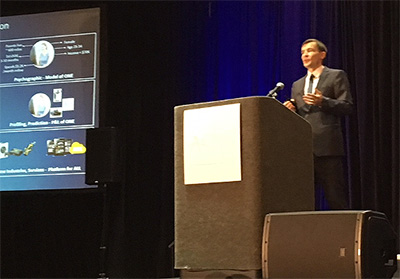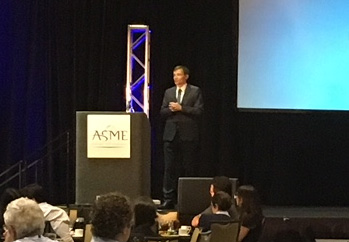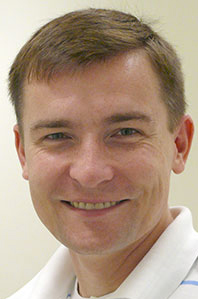IMECE Closing Plenary Explores the Subject of Digital Twin Modeling
IMECE Closing Plenary Explores the Subject of Digital Twin Modeling
Dec. 8, 2017

A crowd of nearly 700 attended the Closing Plenary Luncheon at the ASME 2017 International Mechanical Engineering Congress and Exposition (IMECE) last month in Tampa, Fla., where Aaron Knobloch, senior scientist and program manager at General Electric Global Research Center (GRC), delivered his presentation “When Machines Find Their Voice: The Industrial Internet of Things and Digital Twins.”
Dr. Knobloch’s lively and thought-provoking discussion, which took place Nov. 9 at the Tampa Convention Center, focused on the concept of digital twins — complex physics-based models of equipment fed by continuous real-time sensor data — and how they are revolutionizing the maintenance and optimization of hardware. Much like the user profiles created on Amazon.com when visitors to the site make purchases, digital twin models enable companies like GE to create profiles of the equipment they sell to customers, such locomotives or jet engines, Knobloch said. Driven by “huge changes in our connectivity, the performance of computing, and the cost of sensors and computing” during the past two decades, digital twin models offer hardware operators the opportunity to reduce maintenance costs, optimize asset logistics and make overall operations more efficient, he said.

As an example, Knobloch pointed to electric utilities as operations that could reap the benefits of digital twin modeling. “You think about a power plant,” he said. “How does a power plant operator make money? They make money based on the price of electricity, the fuel input to the gas turbine, and the maintenance cost. Imagine if you could optimize that equation based on the day-to-day changes of those scenarios. For instance, when electricity prices are high, you may want to operate your gas turbine in a more aggressive manner, which may instigate more maintenance costs, but in the overall trade will make the customer more money. So you could imagine new ways to optimize and control based on the business outcomes and how you operate the asset.”
Airlines are another industry where digital twin modeling would be a natural fit, according to Knobloch. Thanks to cloud computing, data from each flight of each individual jet engine can be uploaded, allowing GE to understand how operators are using each engine, he said. “What city is it flying to each day? What were the weather conditions during those cities on those days? When was it last serviced? We have all of this information from inspections and data about temperature that we can apply. And now instead of doing fleet-based analysis where we basically govern the maintenance schedules based on the worst performing asset in the fleet, we’re able to individually do asset-based analytics so that we only have to bring in that particular engine,” Knobloch said.

Once considered a “big iron company” dedicated to manufacturing large mechanical systems such as gas turbines, aircraft engines, locomotives and oil and gas equipment, GE has made inroads into electronics, the industrial internet and digital twin modeling in recent years, Knobloch said. The company recently introduced the hardware platform EDGE OS, which uses machine learning to enable the dynamic tuning of the models based on information shared between the assets.
Knobloch concluded his plenary talk by taking a look at a couple of new developments in the digital twin realm. He discussed new robotic technologies including large and small robots that could be inserted into engines through borescope holes to inspect and repair engines while taking pictures and collecting data. “Borescope inspections and physical pictures can really tell us a lot, and having new ways to get inside the engine and get those pictures would really help inform the digital twin models in the future,” he pointed out.
He also mentioned health care and athletics as areas where human digital twins could have an impact, due to the reduction in cost of wearable sensor technologies, also known as “wearables.” He said this technology would make it possible to “make predictions about sickness, or for athletes, optimized performance based on parameters that (can be measured) more easily because wearable sensors are becoming cheaper and more available to everyone,” Knobloch said.




